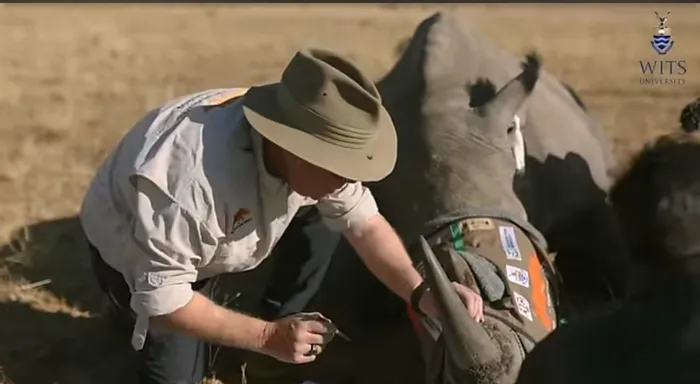Is Wits creating radioactive rhinos? Pioneering radioisotope technology to combat rhino poaching

Professor James Larkin from Wits University's Radiation and Health Physics Unit (RHPU), injecting radioisotopes into a rhino’s horn. Picture: Wits University / Youtube
On June 25, Wits University announced the latest phase of the Rhisotope Project, a pioneering initiative aimed at deterring rhino poaching through the use of radioisotope technology. After three years of research, the project has successfully inserted low doses of radioisotopes into the horns of 20 live rhinoceros.
Professor James Larkin from Wits University's Radiation and Health Physics Unit (RHPU), leading the project, explained that this final phase involves closely monitoring the health and vital statistics of the rhinos over six months. This monitoring aims to determine the viability of using nuclear technology as a conservation tool.
The Rhisotope Project's strategy involves inserting small, measured quantities of radioisotopes into rhino horns, making them detectable by radiation detection portal monitors at international borders, including airports, harbours, and land crossings.
This innovative method aims to create long-lasting and detectable horn markers that are safe for the animals and the environment. Future plans include expanding this technology to protect elephants, pangolins, and other species.
The project is being trialled in the UNESCO Waterberg Biosphere Reserve, leveraging existing nuclear security infrastructure. With over 11,000 radiation detection portal monitors worldwide and thousands of trained personnel, the Rhisotope Project aims to enhance wildlife trafficking detection at ports of entry, an area currently lacking in resources.
“Every 20 hours in South Africa, a rhino dies for its horn. These poached horns are trafficked globally for use in traditional medicines or as status symbols,” said Larkin.
“Rhino horns are now the most valuable commodity in the black market, surpassing gold, platinum, diamonds, and cocaine. Our goal is to devalue rhino horns in the eyes of end-users and make them easier to detect when smuggled across borders.”
Starting on June 24, 2024, Larkin's team sedated the 20 rhinos and drilled small holes into their horns to insert the non-toxic radioisotopes. The rhinos were then released and monitored around the clock by a highly qualified crew for six months.
“Expert veterinarians closely monitored each insertion to prevent any harm to the animals,” said Larkin. “Our research has ensured that the radioisotopes pose no health risk to the rhinos or their caretakers.”
The Rhisotope Project's nuclear technology could deter poaching, increase smuggling detection capabilities, boost prosecution success rates, reveal smuggling routes, and deter end-user markets. South Africa has lost nearly 10,000 rhinos to poaching since 2008.
Professor Lynn Morris, deputy vice-chancellor for research and innovation at Wits University, remarked: “This project exemplifies how cross-disciplinary research and innovation can make a real difference. The Rhisotope Project has the potential to eradicate the threat of extinction for our unique wildlife species, particularly in South Africa and across the continent.”
Established in January 2021, the Rhisotope Project aims to become a global leader in using nuclear technology to protect endangered species and empower local communities. The project also focuses on education and social upliftment, particularly for girls and women in rural areas, fostering local support for conservation efforts.
IOL
Tragedy as 18-year-old Midlands rhino dies after drowning
Kruger National Park winning the fight against rhino poaching, trio convicted
Addo Elephant Park goes green ahead of World Environmental Day
International Day for Biodiversity - youth engagement vital for biodiversity conservation
SANParks makes strides to allow communities to claim land back